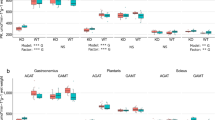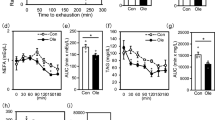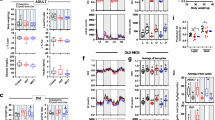Abstract
Background:
Knowledge of the morphological and biochemical alterations occurring in skeletal muscles of obese animals is relatively limited, particularly with respect to non-limb muscles and relationship to fibre type.
Objective:
Sternomastoid (SM; fast-twitch), extensor digitorum longus (EDL; fast-twitch), and soleus (SOL; mixed) muscles of ob/ob mouse (18–22 weeks) were examined with respect to size (mass, muscle mass-to-body mass ratio, cross-sectional area (CSA)), fibre CSA, protein content, myosin heavy chain (MHC) content, MHC isoform (MHCi) composition, MHCi-based fibre type composition, and lactate dehydrogenase isoenzyme (LDHiso) composition.
Results:
Compared with (control) muscles from lean mice, all the three muscles from ob/ob mice were smaller in size (by 13–30%), with SM and EDL being the most affected. The CSA of IIB and IIB+IID fibres (the predominant fibre types in SM and EDL muscles) was markedly smaller (by ∼30%) in ob/ob mice, consistent with differences in muscle size. Total protein content (normalised to muscle mass) was significantly lower in EDL (−9.7%) and SOL (−14.1%) muscles of ob/ob mice, but there were no differences between SM, EDL, and SOL muscles from the two animal groups with respect to MHC content (also normalised to muscle mass). Electrophoretic analyses of MHCi composition in whole muscle homogenates and single muscle fibres showed a shift towards slower MHCi content, slower MHCi containing fibres, and a greater proportion of hybrid fibres in all the three muscles of ob/ob mice, with a shift towards a more aerobic-oxidative phenotype also observed with respect to LDHiso composition.
Conclusion:
This study showed that SM, EDL, and SOL muscles of ob/ob mice display size reductions to an extent that seems to be largely related to fibre type composition, and a shift in fibre type composition that may result from a process of structural remodelling, as suggested by the increased proportion of hybrid fibres in muscles of ob/ob mice.
This is a preview of subscription content, access via your institution
Access options
Subscribe to this journal
Receive 12 print issues and online access
$259.00 per year
only $21.58 per issue
Buy this article
- Purchase on Springer Link
- Instant access to full article PDF
Prices may be subject to local taxes which are calculated during checkout





Similar content being viewed by others
References
Pette D . Skeletal muscle plasticity—history, facts and concepts. In: Bottinelli R, Reggiani C (eds). Skeletal Muscle Plasticity in Health and Disease: From Genes to Whole Muscle. Springer: Dordrecht, 2006.
Bray GA, York DA . Hypothalamic and genetic obesity in experimental animals: an autonomic and endocrine hypothesis. Physiol Rev 1979; 59: 719–809.
Dauncey MJ, Brown D . Role of activity-induced thermogenesis in twenty-four hour energy expenditure of lean and genetically obese (ob/ob) mice. Q J Exp Physiol 1987; 72: 549–559.
Tankersley CG, O'Donnell C, Daood MJ, Watchko JF, Mitzner W, Schwartz A et al. Leptin attenuates respiratory complications associated with the obese phenotype. J Appl Physiol 1998; 85: 2261–2269.
York DA, Hansen B . Animal models of obesity. In: Bray GA, Bouchard C, James WPT (eds). Handbook of Obesity. Marcel Dekker: New York, 1998.
Hotamisligil GS, Shargill NS, Spiegelman BM . Adipose expression of tumor necrosis factor-alpha: direct role in obesity-linked insulin resistance. Science 1993; 259: 87–91.
Almond RE, Enser M . A histochemical and morphological study of skeletal muscle from obese hyperglycaemic ob/ob mice. Diabetologia 1984; 27: 407–413.
Stickland NC, Batt RA, Crook AR, Sutton CM . Inability of muscles in the obese mouse (ob/ob) to respond to changes in body weight and activity. J Anat 1994; 184: 527–533.
Warmington SA, Tolan R, McBennett S . Functional and histological characteristics of skeletal muscle and the effects of leptin in the genetically obese (ob/ob) mouse. Int J Obes Relat Metab Disord 2000; 24: 1040–1050.
Gandevia SC, McKenzie DK, Plassman BL . Activation of human respiratory muscles during different voluntary manoeuvres. J Physiol 1990; 428: 387–403.
Hennig R, Lømo T . Gradation of force output in normal fast and slow muscles of the rat. Acta Physiol Scand 1987; 130: 133–142.
Hitomi Y, Kizaki T, Watanabe S, Matsumura G, Fujioka Y, Haga S et al. Seven skeletal muscles rich in slow muscle fibers may function to sustain neutral position in the rodent hindlimb. Comp Biochem Physiol B Biochem Mol Biol 2005; 140: 45–50.
Brooks SV, Faulkner JA . Contractile properties of skeletal muscles from young, adult and aged mice. J Physiol 1988; 404: 71–82.
Quillin ML, Matthews BW . Accurate calculation of the density of proteins. Acta Crystallogr 2000; D56: 791–794.
Harrington TA, Thomas EL, Frost G, Modi N, Bell JD . Distribution of adipose tissue in the newborn. Pediatr Res 2004; 55: 437–441.
Ford T, Rickwood D, Graham J . Buoyant densities of macromolecules, macromolecular complexes and cell organelles in Nycodenz gradients. Anal Biochem 1983; 128: 232–239.
Lessard SJ, Lo Giudice SL, Lau W, Reid JJ, Turner N, Febbraio MA et al. Rosiglitazone enhances glucose tolerance by mechanisms other than reduction of fatty acid accumulation within skeletal muscle. Endocrinology 2004; 145: 5665–5670.
Goodman CA, Stephenson GM . Glycogen stability and glycogen phosphorylase activities in isolated skeletal muscles from rat and toad. Journal Muscle Res Cell Motil 2000; 21: 655–662.
Kaidanovich-Beilin O, Eldar-Finkelman H . Long-term treatment with novel glycogen synthase kinase-3 inhibitor improves glucose homeostasis in ob/ob mice: molecular characterization in liver and muscle. J Pharmacol Exp Ther 2006; 316: 17–24.
Bortolotto SK, Stephenson DG, Stephenson GM . Fiber type populations and Ca2+-activation properties of single fibers in soleus muscles from SHR and WKY rats. Am J Physiol 1999; 276: C628–C637.
Bradford MM . A rapid and sensitive method for the quantitation of microgram quantities of protein utilizing the principle of protein-dye binding. Anal Biochem 1976; 72: 248–254.
Talmadge RJ, Roy RR . Electrophoretic separation of rat skeletal muscle myosin heavy-chain isoforms. J Appl Physiol 1993; 75: 2337–2340.
Yates LD, Greaser ML . Quantitative determination of myosin and actin in rabbit skeletal muscle. J Mol Biol 1983; 168: 123–141.
Geiger PC, Cody MJ, Macken RL, Sieck GC . Maximum specific force depends on myosin heavy chain content in rat diaphragm muscle fibers. J Appl Physiol 2000; 89: 695–703.
Layne E . Spectrophotometric and turbidimetric methods for measuring proteins. Methods Enzymol 1957; 10: 447–455.
Trostler N, Amin R, Shafrir E . Increased protease activity in muscles of obese- (ob/ob) mice. Int J Obes 1982; 6: 557–566.
Méndez J, Keys A . Density and composition of mammalian muscle. Metabolism 1960; 9: 184–188.
Otis JS, Roy RR, Edgerton VR, Talmadge RJ . Adaptations in metabolic capacity of rat soleus after paralysis. J Appl Physiol 2004; 96: 584–596.
Bruton J, Katz A, Lännergren J, Abbate F, Westerblad H . Regulation of myoplasmic Ca2+ in genetically obese (ob/ob) mouse single skeletal muscle fibres. Pflügers Arch 2002; 444: 692–699.
Seene T, Kaasik P, Pehme A, Alev K, Riso EM . The effect of glucocorticoids on the myosin heavy chain isoforms′ turnover in skeletal muscle. J Steroid Biochem Mol Biol 2003; 86: 201–206.
Tokuyama K, Himms-Hagen J . Increased sensitivity of the genetically obese mouse to corticosterone. Am J Physiol 1987; 252: E202–E208.
Smith CK, Romsos DR . Effects of adrenalectomy on energy balance of obese mice are diet dependent. Am J Physiol 1985; 249: R13–R22.
Ma K, Mallidis C, Artaza J, Taylor W, Gonzalez-Cadavid N, Bhasin S . Characterization of 5′-regulatory region of human myostatin gene: regulation by dexamethasone in vitro. Am J Physiol Endocrinol Metab 2001; 281: E1128–E1136.
Rennie MJ, Wackerhage H, Spangenburg EE, Booth FW . Control of the size of the human muscle mass. Annu Rev Physiol 2004; 66: 799–828.
Ma K, Mallidis C, Bhasin S, Mahabadi V, Artaza J, Gonzalez-Cadavid N et al. Glucocorticoid-induced skeletal muscle atrophy is associated with upregulation of myostatin gene expression. Am J Physiol Endocrinol Metab 2003; 285: E363–E371.
McPherron AC, Lee SJ . Suppression of body fat accumulation in myostatin-deficient mice. J Clin Invest 2002; 109: 595–601.
Gea J, Barreiro E, Orozco-Levi M . Skeletal muscle adaptations to disease states. In: Bottinelli R, Reggiani C (eds). Skeletal Muscle Plasticity in Health and Disease: From Genes to Whole Muscle. Springer: Dordrecht, 2006.
Goodman MN . Tumor necrosis factor induces skeletal muscle protein breakdown in rats. Am J Physiol 1991; 260: E727–E730.
Buck M, Chojkier M . Muscle wasting and dedifferentiation induced by oxidative stress in a murine model of cachexia is prevented by inhibitors of nitric oxide synthesis and antioxidants. EMBO J 1996; 15: 1753–1765.
Cheng J, Turksen K, Yu QC, Schreiber H, Teng M, Fuchs E . Cachexia and graft-vs-host-disease-type skin changes in keratin promoter-driven TNF alpha transgenic mice. Genes Dev 1992; 6: 1444–1456.
Lang CH, Frost RA . Role of growth hormone, insulin-like growth factor-I, and insulin-like growth factor binding proteins in the catabolic response to injury and infection. Curr Opin Clin Nutr Metab Care 2002; 5: 271–279.
Campion DR, Purchas RW, Merkel RA, Romsos DR . Genetic obesity and the muscle satellite cell. Proc Soc Exp Biol Med 1984; 176: 143–147.
Purchas RW, Romsos DR, Allen RE, Merkel RA . Muscle growth and satellite cell proliferative activity in obese (OB/OB) mice. J Anim Sci 1985; 60: 644–651.
Powers SK, Farkas GA, Demirel H, Coombes J, Fletcher L, Hughes MG et al. Effects of aging and obesity on respiratory muscle phenotype in Zucker rats. J Appl Physiol 1996; 81: 1347–1354.
Polla B, Bottinelli R, Sandoli D, Sardi C, Reggiani C . Cortisone-induced changes in myosin heavy chain distribution in respiratory and hindlimb muscles. Acta Physiol Scand 1994; 151: 353–361.
Bonen A, Tan MH, Watson-Wright WM . Insulin binding and glucose uptake differences in rodent skeletal muscles. Diabetes 1981; 30: 702–704.
Marette A, Richardson JM, Ramlal T, Balon TW, Vranic M, Pessin JE et al. Abundance, localization, and insulin-induced translocation of glucose transporters in red and white muscle. Am J Physiol 1992; 263: C443–C452.
Bonen A, Luiken JJ, Liu S, Dyck DJ, Kiens B, Kristiansen S et al. Palmitate transport and fatty acid transporters in red and white muscles. Am J Physiol 1998; 275: E471–E478.
Dyck DJ, Peters SJ, Glatz J, Gorski J, Keizer H, Kiens B et al. Functional differences in lipid metabolism in resting skeletal muscle of various fiber types. Am J Physiol 1997; 272: E340–E351.
Acknowledgements
This work was supported by the Australian Research Council and by the National Health and Medical Research Council of Australia.
Author information
Authors and Affiliations
Corresponding author
Rights and permissions
About this article
Cite this article
Kemp, J., Blazev, R., Stephenson, D. et al. Morphological and biochemical alterations of skeletal muscles from the genetically obese (ob/ob) mouse. Int J Obes 33, 831–841 (2009). https://doi.org/10.1038/ijo.2009.100
Received:
Revised:
Accepted:
Published:
Issue Date:
DOI: https://doi.org/10.1038/ijo.2009.100
Keywords
This article is cited by
-
Differences in the absolute muscle strength and power of children and adolescents with overweight or obesity: a systematic review
BMC Pediatrics (2023)
-
Investigating a dose–response relationship between high-fat diet consumption and the contractile performance of isolated mouse soleus, EDL and diaphragm muscles
European Journal of Applied Physiology (2019)
-
Obesity and related consequences to ageing
AGE (2016)
-
Protein Metabolism in Human Obesity: A Shift in Focus From Whole‐Body to Skeletal Muscle
Obesity (2011)
-
Exercise improves skeletal muscle insulin resistance without reduced basal mTOR/S6K1 signaling in rats fed a high-fat diet
European Journal of Applied Physiology (2011)



